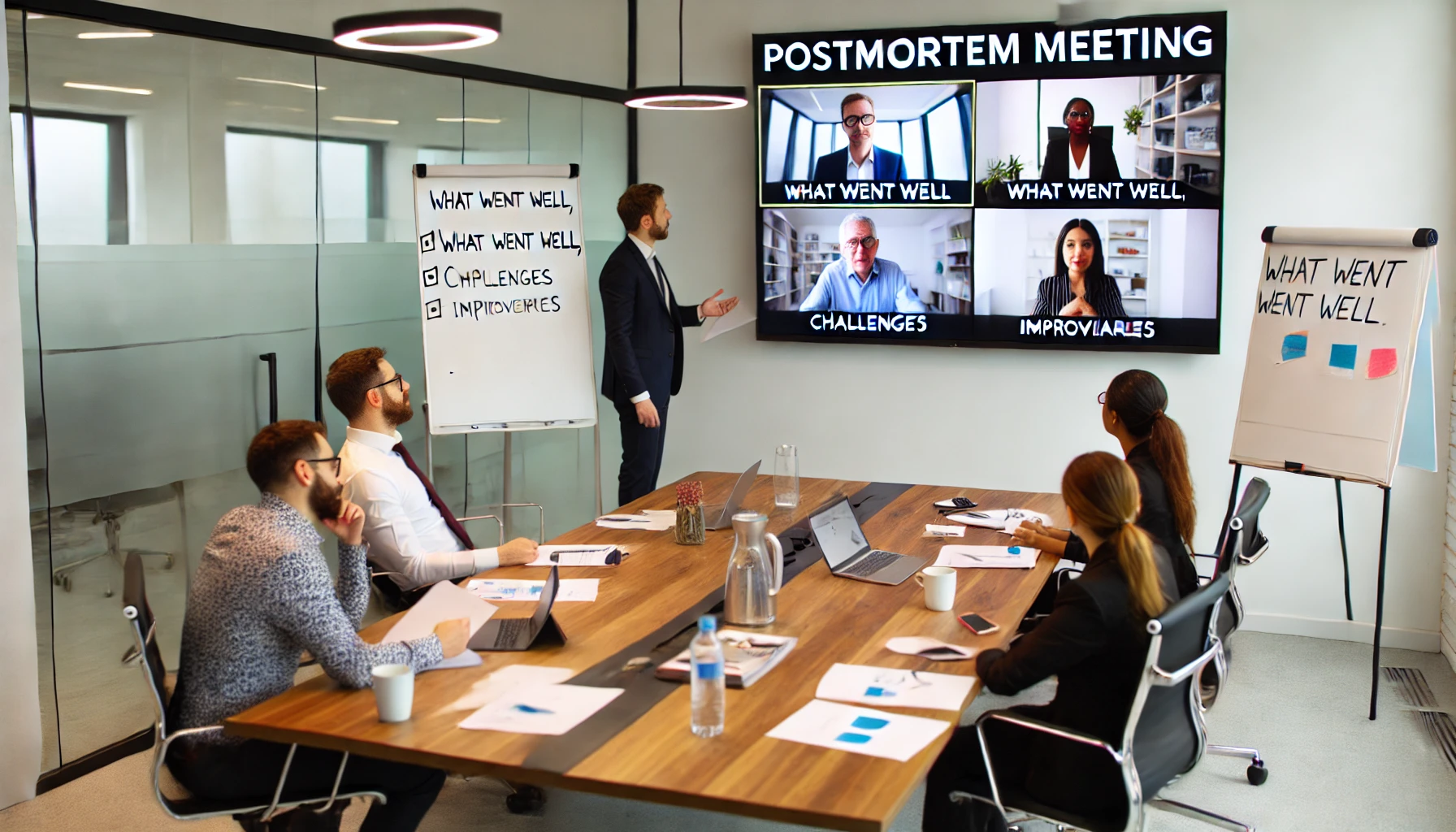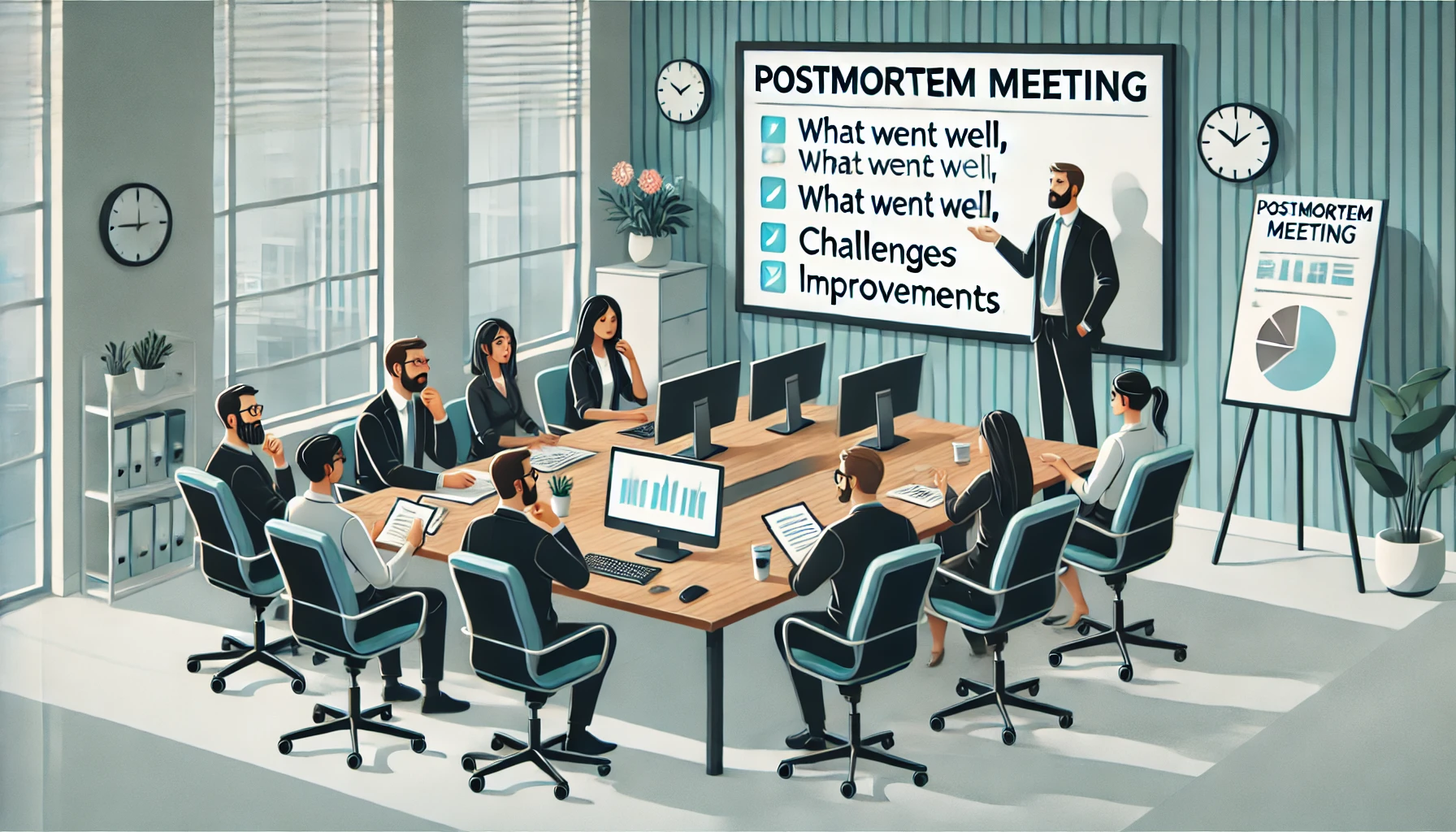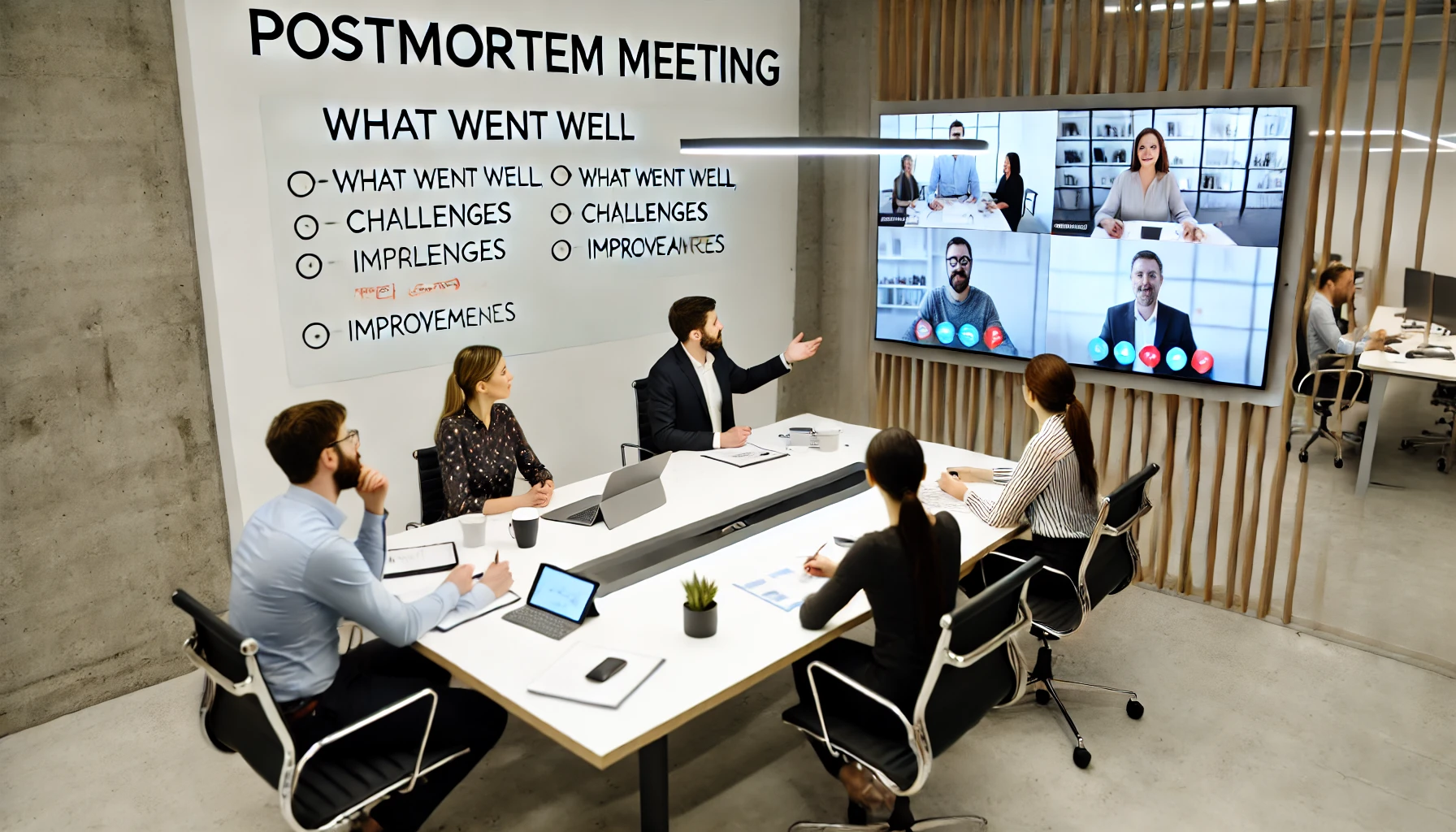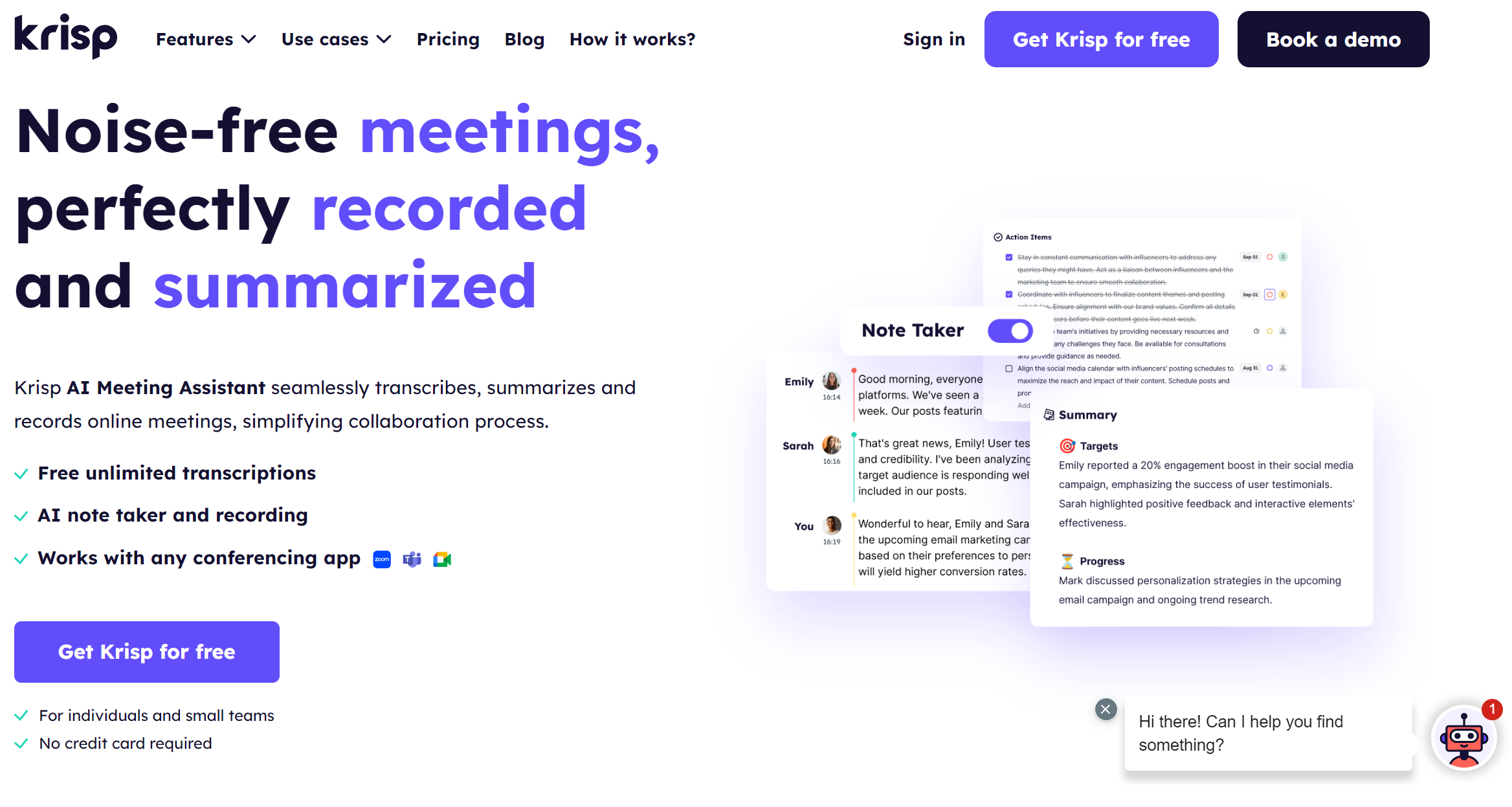
You wrapped up a project and thought, “What could we’ve done differently?” right? That’s where a post mortem meeting comes into play. These meetings are invaluable for dissecting what went right, what went wrong, and how to improve for next time.
This article explains the post mortem meeting meaning and its benefits and reveals what should be covered in a post mortem meeting. Moreover, it provides steps and best practices to run a post mortem effectively.
Importantly, let’s unveil how AI Meeting Assistant Krisp can make your meetings far more productive and effective.

A post mortem meeting is a session to analyze project outcomes after a project or significant event. What is the purpose of the post mortem? These meetings aim to identify successes, failures, and areas for improvement.
Think of this meeting as a reflective process that helps teams learn and grow, ensuring better performance in future projects. Importantly, teams shouldn’t use these meetings to lay blame on members.
Instead, these gatherings should help teams assess projects’ success and failure and identify steps to improve future projects.
What about the difference between project post mortem and premortem meetings? As the name says, premortem meetings occur before a project starts. These meetings aim to anticipate potential failures and challenges. How?
Participants imagine that the project has failed, working backward to identify the reasons for that failure. And such a proactive approach helps teams uncover risks and plan strategies to prevent issues before they arise.
Premortem meeting benefits include enhanced foresight and risk management, increasing the likelihood of project success.
Compared, the goal of the post mortem is to learn from past experiences, identify successes and failures, and develop actionable steps for improvement.
Post mortem meetings provide valuable insights and lessons that you can use to improve future projects. We’ll discuss additional benefits below.
What’s another name for a post mortem meeting? Here are different names:
This one is typical of the Agile and Scrum project management methodologies. A retrospective is about reflecting on the past iteration to improve future sprints. Project management involves planning, initiation, execution, monitoring, and closing.
Agile Project Management (APM) plans and guides project processes using smaller cycles (sprints) or iterations. And the Scrum methodology is focused on teamwork and accountability toward a well-defined goal.
Example: “In our last sprint, we delivered features on time but faced issues with code quality. How can we address this in the next sprint?”
This one is common in military and emergency services. It emphasizes a thorough review of actions taken during an operation.
Specifically, debrief meetings are structured discussions about how team members worked toward achieving a common goal. The latter can include a project, event, or a significant undertaking.
Example: “Our communication was efficient during the emergency drill, but there were delays in resource deployment. How can we streamline this process?”
This one is typical of military and business settings. It’s focused on evaluating what happened, why it happened, and how it can be improved next time.
During an after-action review meeting, participants discuss the objectives, processes, outcomes, and challenges. They discuss the areas for improvement, project success, best practices, and further steps.
Example: “Our product launch showed high engagement but encountered logistical issues. What were the root causes, and how can we avoid them in the future?”
A project recap post mortem focuses on reviewing the entire project lifecycle. It summarizes key events, milestones, achievements, and challenges encountered.
Moreover, it provides a comprehensive overview, helping the team understand the project’s trajectory and outcomes. Finally, this meeting highlights major project successes and areas for improvement, serving as a holistic review.
Example: “Our marketing campaign met its targets in quarter one (Q1) but faced challenges in Q2 due to budget constraints.”
A wrap-up meeting is held after the project to finalize loose ends and ensure all deliverables are completed.
This meeting focuses on administrative closure. Specifically, it aims to verify that all tasks are finished and discuss any final feedback. Finally, it ensures the project is formally closed, and all responsibilities are fulfilled.
Example: “Let’s confirm that client deliverables have been met and review the remaining documentation.”
A lessons learned postmortem meeting aims to identify valuable insights gained during the project.
The focus is on extracting actionable lessons from successes and failures. Namely, this meeting aims to document these insights to improve future projects. Thus, it fosters a culture of continuous improvement and learning, boosting team morale .
Example: “Daily stand-ups significantly improved team communication and alignment.”

A post mortem report documents the meeting outcomes, summarizing key findings, successes, failures, and actionable steps for future improvement.
The different types of post mortem reports serve as a reference for the team to understand what worked, what didn’t, and how to enhance future projects. Here are the types:
The systematic use of post mortem reports allows teams to continuously improve their processes. Additionally, it enables teams to avoid repeating past mistakes and problems caused by risks.
Did you know cybercrime, IT outages, and data breaches were the leading risks for small businesses globally in 2023 ? And quality of labor is the most important problem for small businesses in the US in 2024 .

According to Investopedia, nearly 45% of new businesses don’t continue after the first five years. And poor market research and a lack of a proper business plan are the top reasons for business failure .
After all, effective communication in business management is critical to business success as it builds a company’s reputation, reduces mismanagement, and prevents poor business results.
Interestingly, researchers at the NeuroLeadership Institute have shown that by enhancing cognitive processes, leaders can hold their teams more accountable for their teams. And this helps teams successfully meet deadlines, hit targets, and increase revenues.
According to Forbes , companies with high engagement earn 21% more profit. Moreover, companies witness 17% more productivity.
Employees often find meetings irritating and a waste of time. That’s where meeting norms step in to make team discussions productive and engaging. These norms can include setting clear objectives and respecting different viewpoints.
So, how can you organize a post mortem meeting to quickly understand the mistakes, missteps, and successes affecting your project? Let me show you how:

Imagine you’ve just completed a software development project. Here’s how to run your post mortem:

Have you ever participated in a five-minute meeting with only five people that was more effective and productive than an hour-long meeting with all team members?
That’s because the meeting was organized using best practices and the right technology, like Krisp , to enhance productivity. In fact, to say AI Meeting Assistant Krisp plays a considerable role in our increasingly remote world is to say nothing.
Collaboration technologies like Krisp make meetings much more equitable and effective. How? Krisp helps effortlessly overcome remote and hybrid workplace challenges like poor collaboration and weak decision-making.
Let me explain how.
The rise of video-conferencing technologies like Zoom and Google Meet has improved access to remote meetings. Did you know that technology implemented poorly is the top enterprise technology challenge in 2024?
Thankfully, the Krisp AI Meeting Assistant is designed with productivity and efficiency in mind to revolutionize your post mortem meeting. With Krisp, the leader in Productivity Voice AI, you can easily sidestep modern workplace challenges.
Specifically, Voice AI technology like Krisp reduces noise-related issues by 78%. So, it’s no wonder that audio improvement and noise reduction take the meeting experience to the next level, eliminating stress and frustration.
By facilitating meeting processes, Krisp eliminates main pain points, such as miscommunication and poor decision-making .
Thus, Krisp enables you to:
As a resuly, this intelligent Meeting Assistant enhances collaboration and communication and elevates teamwork .
Moreover, Krisp boosts meeting productivity and engagement. Naturally, such increased productivity improves our quality of life, making our lives easier.
You can use Krisp on Windows, Mac, Linux, iOS, or Android. Moreover, you can integrate Krisp with any virtual conferencing platform, including Zoom, Google Meet, and Microsoft Teams.
Best practices represent guidelines, ethics, or ideas that help you most effectively organize your business processes. Here are post mortem meeting standards or ethical guidelines offering the best course of action in meeting organization:
A post mortem meeting is conducted at the end of a project. It helps teams ensure comprehensive project reviews, formal closures, and valuable lessons learned for project success. These meetings are essential for continuous improvement and team growth.
Importantly, Krisp Meeting Assistant can enhance your meeting post mortem by ensuring clear communication through Noise Cancellation, Meeting Recording Transcriptions, and Summaries. As a result, you can enjoy far more efficient and productive online meetings.
This process is held after a project to determine what went wrong and what went right. By determining what was successful and unsuccessful, you can identify future steps for business process improvements. Moreover, you can avoid future risks and promote iterative best practices.
What's Another Word for Post Mortem Meeting?“Retrospective,” “After-Action Review” or “Critical Incident Review,” “Project Recap,” “Wrap-Up Meeting,” “Project Debrief,” and “Lessons Learned Meeting” are other words for a post mortem.
What Is a Post Mortem Interview?This structured discussion is conducted after a project or event to evaluate its outcomes. During these interviews, participants review successes, failures, and lessons learned to improve future performance. Specifically, the project manager collects detailed feedback from attendees to identify pain points and actionable insights.
What Is the Difference Between Post Mortem and Retrospective Meeting?Postmortem Meetings:
Retrospective Meetings: